Assessing Anatase TiO2 Nanofluids Performance: Experimental Heat Transfer Coefficients vs. Mouromtseff Number Ratios
Abstract
:1. Introduction
2. Materials and Methods
2.1. Materials
2.2. Methodology
2.2.1. Characterisation of Nanopowder and Nanofluid Stability
2.2.2. Thermophysical and Rheological Properties
2.2.3. Figures-of-Merit Determination
2.2.4. Experimental Heat Transfer Analysis
3. Results
3.1. Nanopowder Characterisation
3.2. Nanofluid Stability
3.3. Thermophysical and Rheological Profiles
3.4. Heat Transfer Efficiency Evaluation with Mouromtseff Number
4. Conclusions
Author Contributions
Funding
Institutional Review Board Statement
Informed Consent Statement
Data Availability Statement
Acknowledgments
Conflicts of Interest
References
- Said, Z.; Sundar, L.S.; Tiwari, A.K.; Ali, H.M.; Sheikholeslami, M.; Bellos, E.; Babar, H. Recent advances on the fundamental physical phenomena behind stability, dynamic motion, thermophysical properties, heat transport, applications, and challenges of nanofluids. Phys. Rep. 2022, 946, 1–94. [Google Scholar] [CrossRef]
- Vajjha, R.S.; Das, D.K. A review and analysis on influence of temperature and concentration of nanofluids on thermophysical properties, heat transfer and pumping power. Int. J. Heat Mass Transf. 2012, 55, 4063–4078. [Google Scholar] [CrossRef]
- Dittus, F.W.; Boelter, L.M.K. Heat transfer in automobile radiators of the tubular type. Int. Commun. Heat Mass Transf. 1985, 12, 3–22. [Google Scholar] [CrossRef]
- Yu, W.; France, D.M.; Timofeeva, E.V.; Singh, D.; Routbort, J.L. Comparative review of turbulent heat transfer of nanofluids. Int. J. Heat Mass Transf. 2012, 55, 5380–5396. [Google Scholar] [CrossRef]
- Mouromtseff, I.E. Water and Forced-Air Cooling of Vacuum Tubes Nonelectronic Problems in Electronic Tubes. Proc. IRE 1942, 30, 190–205. [Google Scholar] [CrossRef]
- Vallejo, J.P.; Pérez-Tavernier, J.; Cabaleiro, D.; Fernández-Seara, J.; Lugo, L. Potential heat transfer enhancement of functionalized graphene nanoplatelet dispersions in a propylene glycol-water mixture. Thermophysical profile. J. Chem. Thermodyn. 2018, 123, 174–184. [Google Scholar] [CrossRef]
- Ashrae, A.H.F.; Atlanta, G. American Society of Heating, 2009 ASHRAE Handbook: Fundamentals, SI ed.; American Society of Heating, Refrigeration and Air-Conditioning Engineers: Atlanta, GA, USA, 2009; Available online: http://app.knovel.com/hotlink/toc/id:kpASHRAE37/2009-ashrae-handbook (accessed on 6 November 2023).
- Yu, W.; Timofeeva, E.V.; Singh, D.; France, D.M.; Smith, R.K. Investigations of heat transfer of copper-in-Therminol 59 nanofluids. Int. J. Heat Mass Transf. 2013, 64, 1196–1204. [Google Scholar] [CrossRef]
- Cabaleiro, D.; Colla, L.; Agresti, F.; Lugo, L.; Fedele, L. Transport properties and heat transfer coefficients of ZnO/(ethylene glycol+water) nanofluids. Int. J. Heat Mass Transf. 2015, 89, 433–443. [Google Scholar] [CrossRef]
- Elcioglu, E.B.; Genc, A.M.; Karadeniz, Z.H.; Ezan, M.A.; Turgut, A. Nanofluid figure-of-merits to assess thermal efficiency of a flat plate solar collector. Energy Convers. Manag. 2020, 204, 112292. [Google Scholar] [CrossRef]
- Sahoo, R.R.; Sarkar, J. Experimental study on hydrothermal characteristics of shell and tube heat exchanger using phase change material-based hybrid nanofluid. Heat Mass Transf. 2024, 60, 519–533. [Google Scholar] [CrossRef]
- Hao, X.; Peng, B.; Chen, Y.; Xie, G. Experimental Investigation on Heat Transfer Performance of a Flat Plate Heat Pipe With MWCNTS-Acetone Nanofluid. ASME J. Heat Mass Transf. 2017, 139, 062001. [Google Scholar] [CrossRef]
- Azmi, W.H.; Sharma, K.V.; Sarma, P.K.; Mamat, R.; Anuar, S.; Rao, V.D. Experimental determination of turbulent forced convection heat transfer and friction factor with SiO2 nanofluid. Exp. Therm. Fluid Sci. 2013, 51, 103–111. [Google Scholar] [CrossRef]
- Pandey, S.D.; Nema, V.K. Experimental analysis of heat transfer and friction factor of nanofluid as a coolant in a corrugated plate heat exchanger. Exp. Therm. Fluid Sci. 2012, 38, 248–256. [Google Scholar] [CrossRef]
- Nguyen, C.T.; Galanis, N.; Polidori, G.; Fohanno, S.; Popa, C.V.; Le Bechec, A. An experimental study of a confined and submerged impinging jet heat transfer using Al2O3-water nanofluid. Int. J. Therm. Sci. 2009, 48, 401–411. [Google Scholar] [CrossRef]
- Khanlari, A.; Sözen, A.; Variyenli, H.İ. Simulation and experimental analysis of heat transfer characteristics in the plate type heat exchangers using TiO2/water nanofluid. Int. J. Numer. Methods Heat Fluid Flow 2019, 29, 1343–1362. [Google Scholar] [CrossRef]
- Ulhakim, M.T.; Sukarman; Khoirudin; Fazrin, N.; Irfani, T.; Abdulah, A. Qualitative Stability and Thermal Properties Investigation of TiO2-EG/W Nanofluids Through Experimental Validation. J. Asiimetrik 2023, 6, 143–152. [Google Scholar]
- Zhang, H.; Qing, S.; Xu, J.; Zhang, X.; Zhang, A. Stability and thermal conductivity of TiO2/water nanofluids: A comparison of the effects of surfactants and surface modification. Colloids Surf. A Physicochem. Eng. Asp. 2022, 641, 128492. [Google Scholar] [CrossRef]
- Satti, J.R.; Das, D.K.; Ray, D. Investigation of the thermal conductivity of propylene glycol nanofluids and comparison with correlations. Int. J. Heat Mass Transf. 2017, 107, 871–881. [Google Scholar] [CrossRef]
- Satti, J.R.; Das, D.K.; Ray, D. Specific heat measurements of five different propylene glycol based nanofluids and development of a new correlation. Int. J. Heat Mass Transf. 2016, 94, 343–353. [Google Scholar] [CrossRef]
- Leena, M.; Srinivasan, S. Experimental Investigation of the Thermophysical Properties of TiO2/Propylene Glycol–Water Nanofluids for Heat-Transfer Applications. J. Eng. Phys. Thermophys. 2018, 91, 498–506. [Google Scholar] [CrossRef]
- Scherrer, P. Bestimmung der inneren Struktur und der Größe von Kolloidteilchen mittels Röntgenstrahlen. In Kolloidchemie Ein Lehrbuch. Chemische Technologie in Einzeldarstellungen; Springer: Berlin/Heidelberg, Germany, 1912. [Google Scholar] [CrossRef]
- Suganthi, K.S.; Rajan, K.S. Metal oxide nanofluids: Review of formulation, thermo-physical properties, mechanisms, and heat transfer performance. Renew. Sustain. Energy Rev. 2017, 76, 226–255. [Google Scholar] [CrossRef]
- Simons, R.E. Calculation corner: Comparing heat transfer rates of liquid coolants using the Mouromtseff number. Electronics Cool. 2006, 12, 10. [Google Scholar]
- Vallejo, J.P.; Calviño, U.; Freire, I.; Fernández-Seara, J.; Lugo, L. Convective heat transfer in pipe flow for glycolated water-based carbon nanofluids. A thorough analysis. J. Mol. Liq. 2020, 301, 112370. [Google Scholar] [CrossRef]
- Lienhard, J.H. A Heat Transfer Textbook; Phlogistron: Cambridge, MA, USA, 2005. [Google Scholar]
- Gnielinski, V. G2 Heat Transfer in Concentric Annular and Parallel Plate Ducts. In VDI Heat Atlas; Springer: Berlin/Heidelberg, Germany, 2010; pp. 701–708. [Google Scholar] [CrossRef]
- Song, N.W.; Park, K.M.; Lee, I.H.; Huh, H. Uncertainty estimation of nanoparticle size distribution from a finite number of data obtained by microscopic analysis. Metrologia 2009, 46, 480. [Google Scholar] [CrossRef]
- Antić, Ž.; Krsmanović, R.M.; Nikolić, M.G.; Marinović-Cincović, M.; Mitrić, M.; Polizzi, S.; Dramićanin, M.D. Multisite luminescence of rare earth doped TiO2 anatase nanoparticles. Mater. Chem. Phys. 2012, 135, 1064–1069. [Google Scholar] [CrossRef]
- Rehman, A.; Yaqub, S.; Ali, M.; Nazir, H.; Shahzad, N.; Shakir, S.; Liaquat, R.; Said, Z. Effect of surfactants on the stability and thermophysical properties of Al2O3+TiO2 hybrid nanofluids. J. Mol. Liq. 2023, 391, 123350. [Google Scholar] [CrossRef]
- Holmberg, J.P.; Ahlberg, E.; Bergenholtz, J.; Hassellöv, M.; Abbas, Z. Surface charge and interfacial potential of titanium dioxide nanoparticles: Experimental and theoretical investigations. J. Colloid. Interface Sci. 2013, 407, 168–176. [Google Scholar] [CrossRef] [PubMed]
- Feng, T.; Li, L.; Shi, Q.; Zhang, Y.; Li, G. Heat capacity and thermodynamic functions of TiO2(H). J. Chem. Thermodyn. 2020, 145, 106040. [Google Scholar] [CrossRef]
- Calviño, U.; Montenegro, I.; Murshed, S.M.S.; Fernández-Seara, J.; Vallejo, J.P.; Lugo, L. Heat transfer and hydrodynamic performance of ZrO2 geothermal nanofluids through tubular and plate heat exchangers. Appl. Therm. Eng. 2024, 253, 123770. [Google Scholar] [CrossRef]
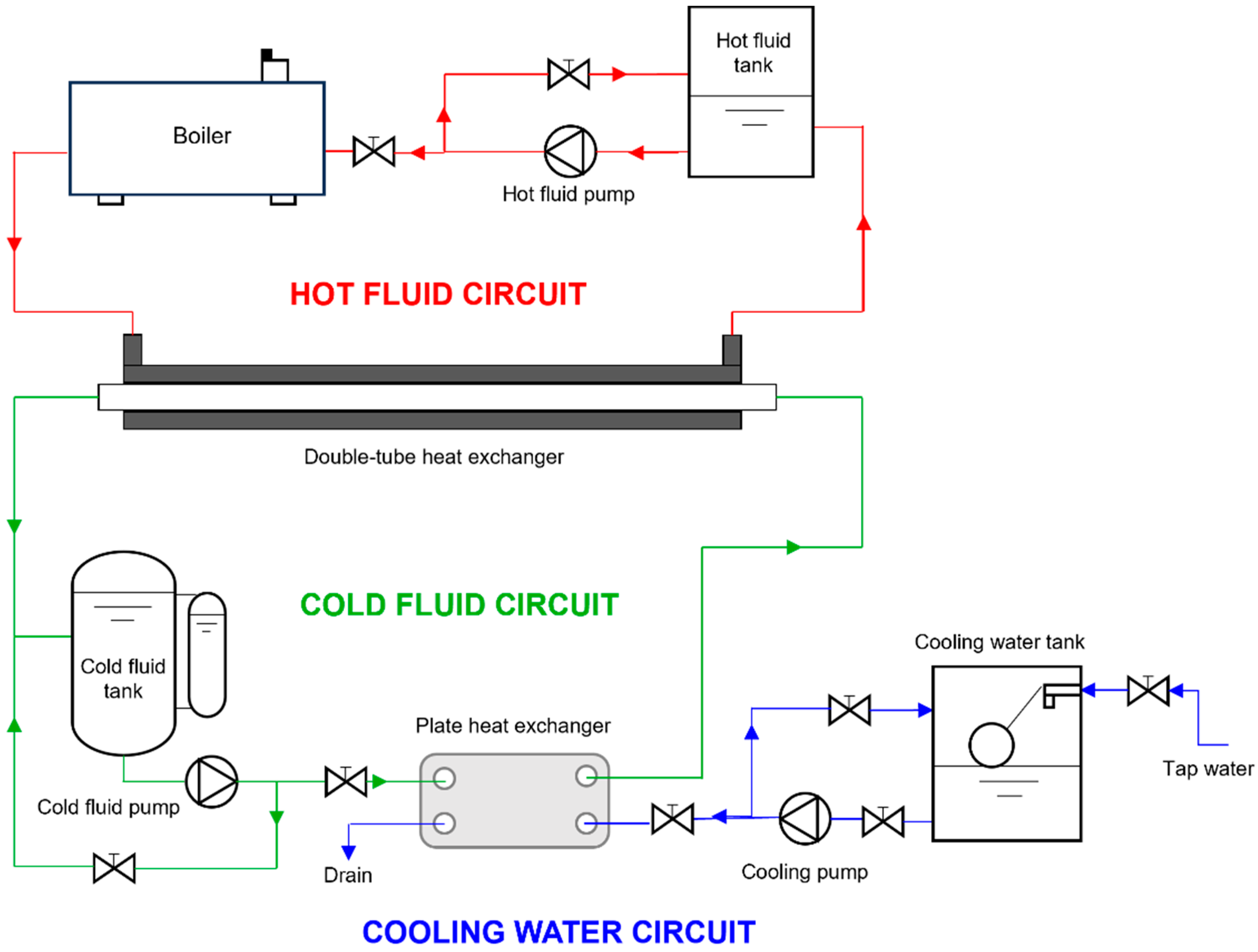
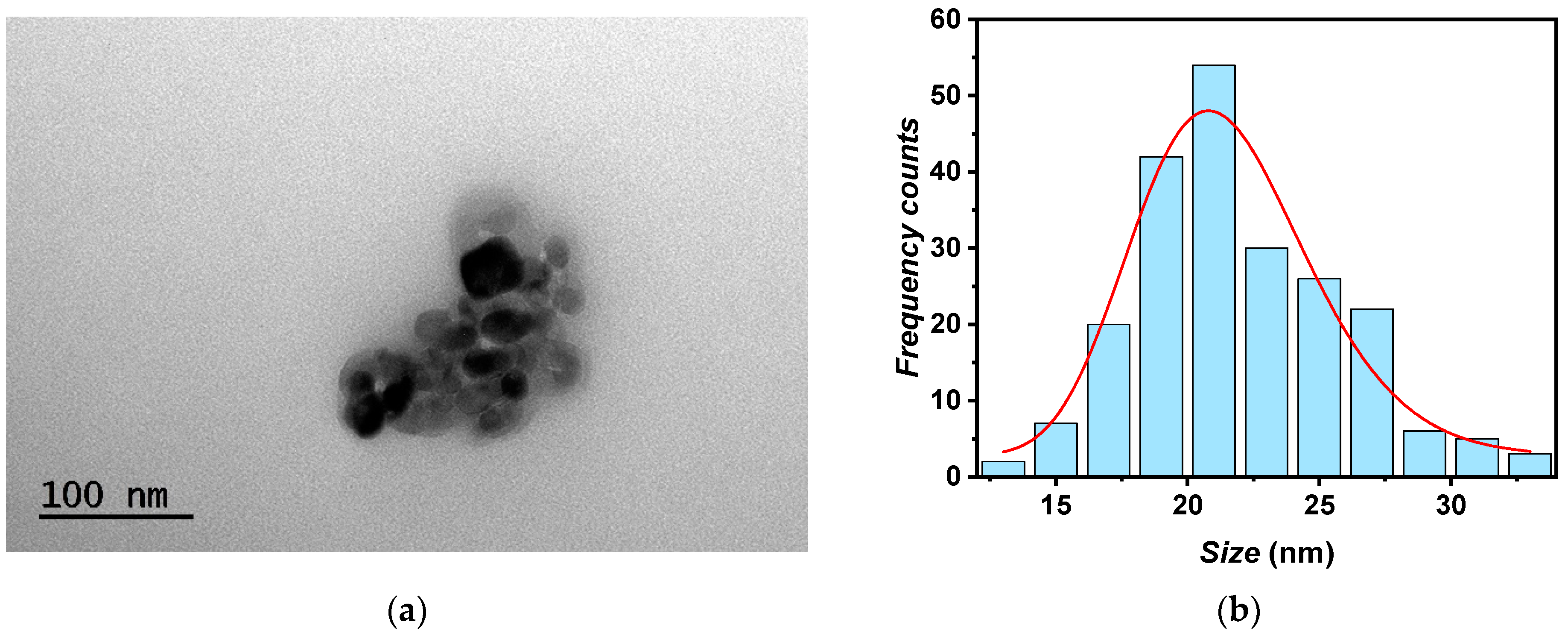
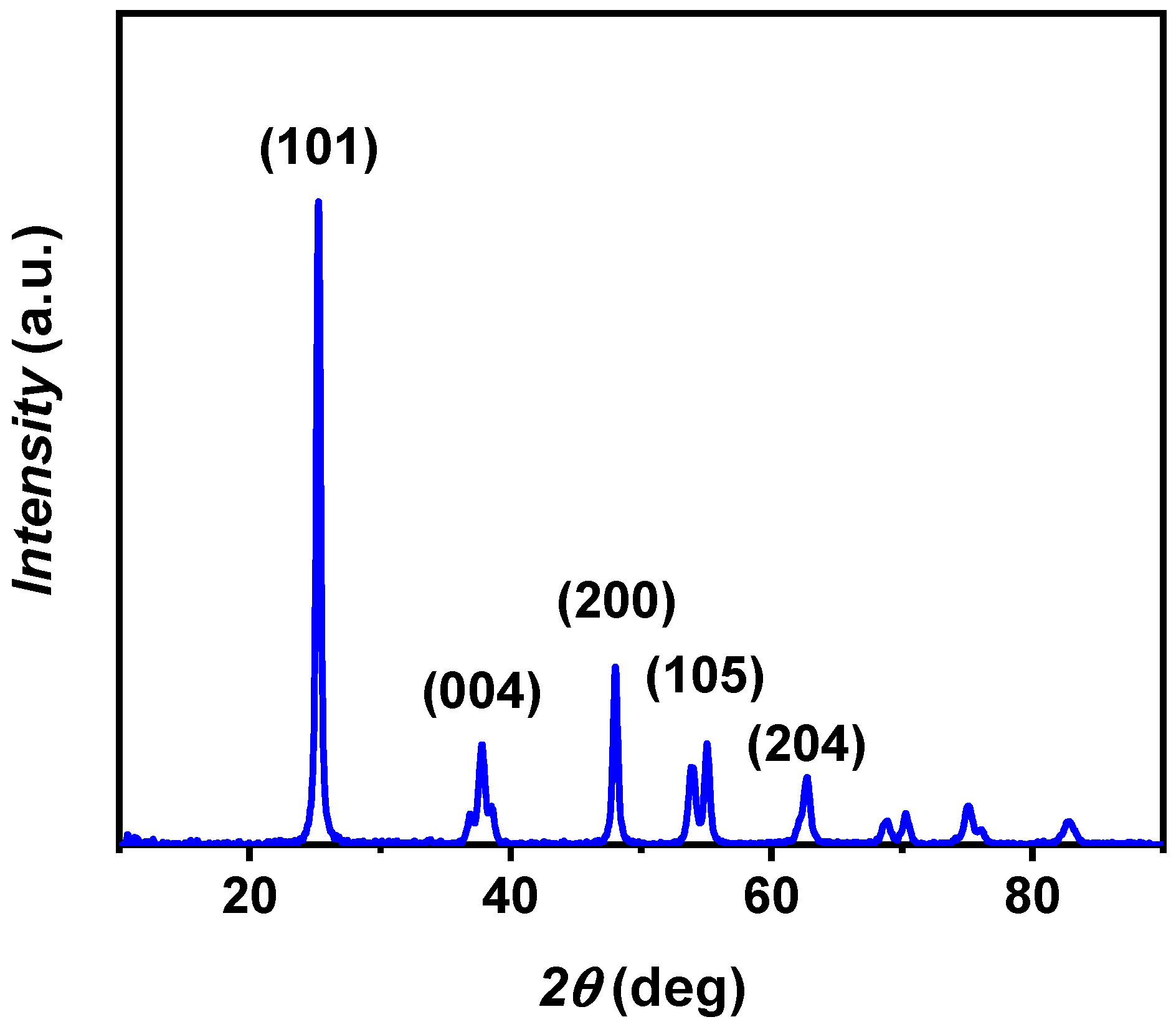
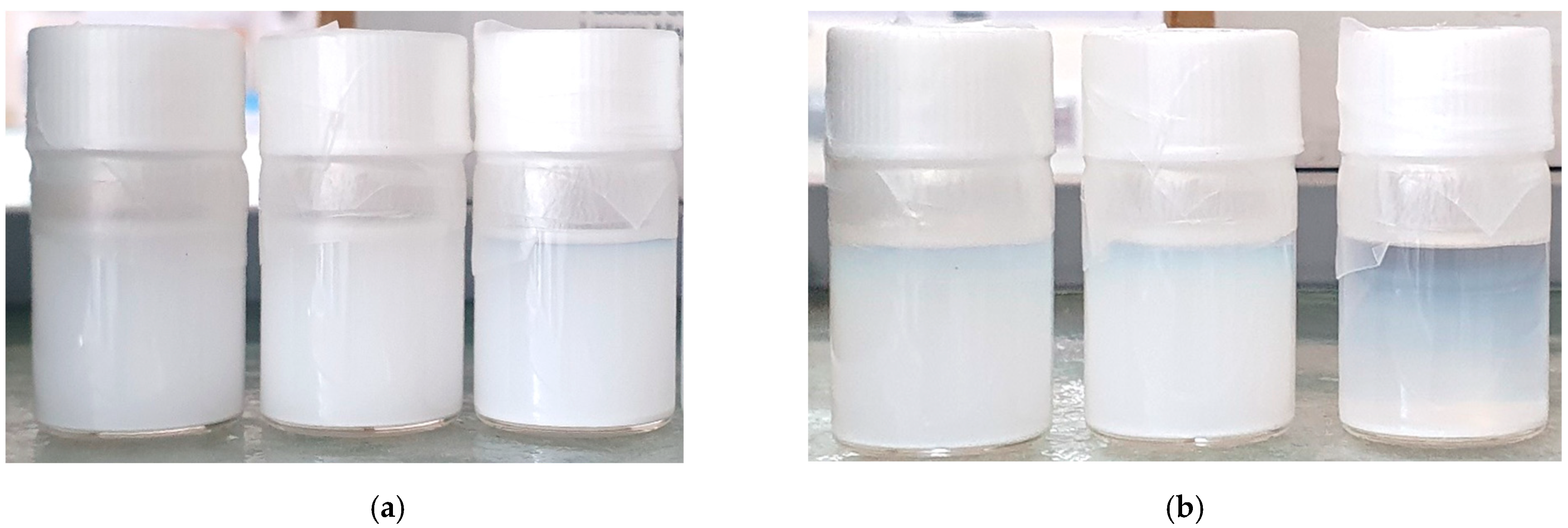



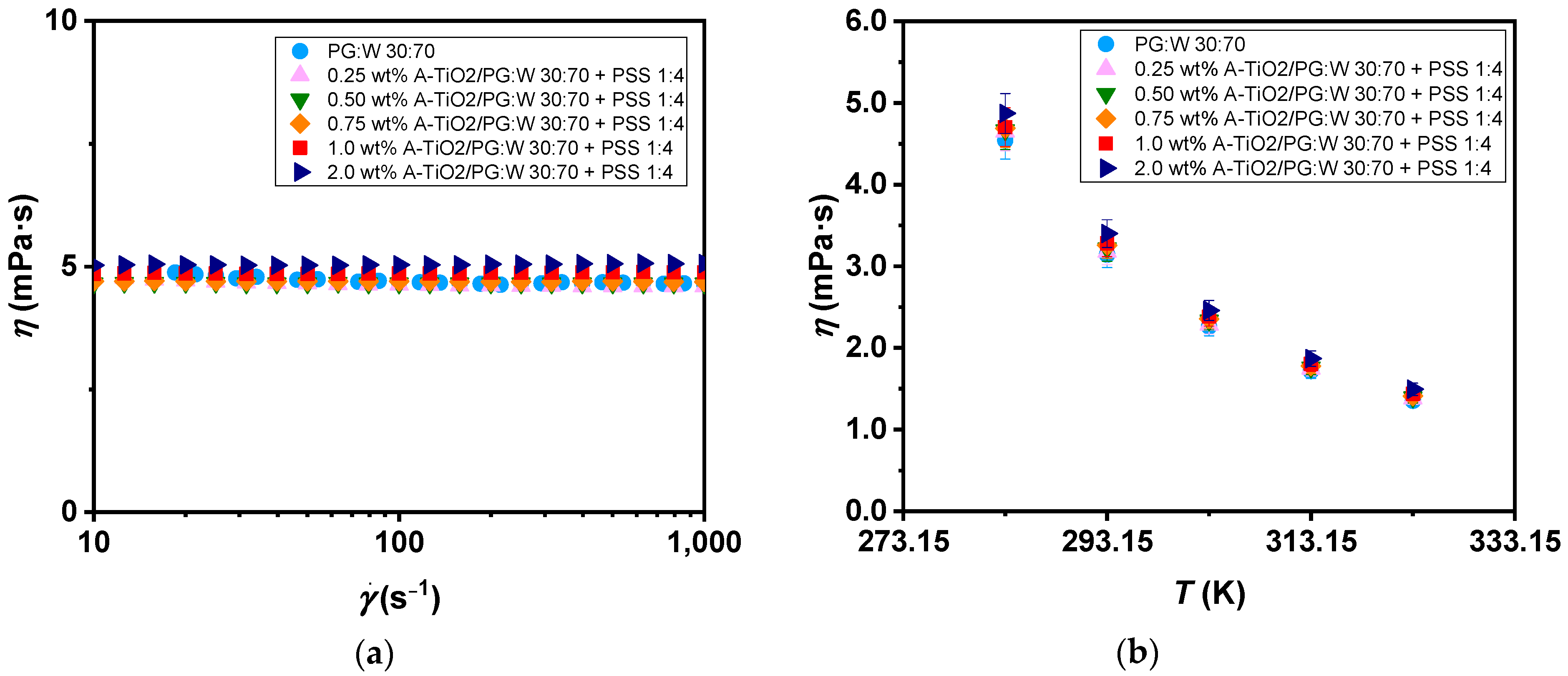

| Sample | Temperature (K) | Re | ||||
|---|---|---|---|---|---|---|
| 0.25 wt% A-TiO2/PG:W 30:70 vol% + PSS 1:4 | 298 | 4954 | 0.939 | 0.992 | 0.991 | 0.991 |
| 6604 | 0.939 | 0.991 | 0.990 | 0.990 | ||
| 8271 | 0.940 | 0.992 | 0.991 | 0.991 | ||
| 9921 | 0.938 | 0.991 | 0.990 | 0.990 | ||
| 11,629 | 0.939 | 0.992 | 0.991 | 0.991 | ||
| 308 | 6981 | 0.945 | 0.994 | 0.994 | 0.994 | |
| 9300 | 0.945 | 0.993 | 0.992 | 0.993 | ||
| 11,684 | 0.952 | 0.996 | 0.996 | 0.996 | ||
| 13,951 | 0.946 | 0.993 | 0.993 | 0.993 | ||
| 16,313 | 0.945 | 0.997 | 0.998 | 0.998 | ||
| 318 | 8963 | 0.954 | 0.992 | 0.991 | 0.991 | |
| 11,958 | 0.954 | 0.992 | 0.992 | 0.992 | ||
| 14,917 | 0.957 | 0.992 | 0.992 | 0992 | ||
| 17,888 | 0.953 | 0.992 | 0.991 | 0.991 | ||
| 20,885 | 0.953 | 0.992 | 0.992 | 0.992 | ||
| 1.0 wt% A-TiO2/PG:W 30:70 vol% + PSS 1:4 | 298 | 4834 | 0.923 | 0.961 | 0.965 | 0.963 |
| 6447 | 0.907 | 0.960 | 0.964 | 0.963 | ||
| 8052 | 0.896 | 0.959 | 0.963 | 0.962 | ||
| 9649 | 0.885 | 0.958 | 0.961 | 0.960 | ||
| 11,306 | 0.875 | 0.959 | 0.963 | 0.962 | ||
| 308 | 6720 | 0.916 | 0.958 | 0.961 | 0.960 | |
| 8964 | 0.902 | 0.958 | 0.960 | 0.960 | ||
| 11,241 | 0.895 | 0.960 | 0.963 | 0.962 | ||
| 13,459 | 0.880 | 0.958 | 0.961 | 0.960 | ||
| 15,728 | 0.869 | 0.962 | 0.966 | 0.965 | ||
| 318 | 8653 | 0.910 | 0.958 | 0.960 | 0.960 | |
| 11,530 | 0.896 | 0.958 | 0.960 | 0.960 | ||
| 14,402 | 0.884 | 0.959 | 0.961 | 0.961 | ||
| 17,285 | 0.873 | 0.958 | 0.961 | 0.960 | ||
| 20,202 | 0.865 | 0.958 | 0.960 | 0.960 | ||
| 2.0 wt% A-TiO2/PG:W 30:70 vol% + PSS 1:4 | 298 | 4697 | 0.840 | 0.936 | 0.941 | 0.939 |
| 6267 | 0.821 | 0.936 | 0.941 | 0.939 | ||
| 7824 | 0.806 | 0.935 | 0.939 | 0.938 | ||
| 9412 | 0.791 | 0.935 | 0.940 | 0.938 | ||
| 10,963 | 0.777 | 0.934 | 0.938 | 0.937 | ||
| 308 | 6573 | 0.828 | 0.936 | 0.941 | 0.939 | |
| 8748 | 0.809 | 0.935 | 0.939 | 0.938 | ||
| 10,963 | 0.798 | 0.936 | 0.941 | 0.940 | ||
| 13,222 | 0.783 | 0.938 | 0.943 | 0.941 | ||
| 15,284 | 0.766 | 0.937 | 0.942 | 0.940 | ||
| 318 | 8404 | 0.818 | 0.932 | 0.936 | 0.935 | |
| 11,210 | 0.798 | 0.933 | 0.937 | 0.935 | ||
| 14,023 | 0.782 | 0.934 | 0.938 | 0.937 | ||
| 16,858 | 0.767 | 0.934 | 0.939 | 0.937 | ||
| 19,639 | 0.757 | 0.933 | 0.936 | 0.935 |
Disclaimer/Publisher’s Note: The statements, opinions and data contained in all publications are solely those of the individual author(s) and contributor(s) and not of MDPI and/or the editor(s). MDPI and/or the editor(s) disclaim responsibility for any injury to people or property resulting from any ideas, methods, instructions or products referred to in the content. |
© 2024 by the authors. Licensee MDPI, Basel, Switzerland. This article is an open access article distributed under the terms and conditions of the Creative Commons Attribution (CC BY) license (https://creativecommons.org/licenses/by/4.0/).
Share and Cite
Calviño, U.; Prado, J.I.; Vallejo, J.P.; Lugo, L. Assessing Anatase TiO2 Nanofluids Performance: Experimental Heat Transfer Coefficients vs. Mouromtseff Number Ratios. Appl. Sci. 2024, 14, 7647. https://doi.org/10.3390/app14177647
Calviño U, Prado JI, Vallejo JP, Lugo L. Assessing Anatase TiO2 Nanofluids Performance: Experimental Heat Transfer Coefficients vs. Mouromtseff Number Ratios. Applied Sciences. 2024; 14(17):7647. https://doi.org/10.3390/app14177647
Chicago/Turabian StyleCalviño, Uxía, Jose I. Prado, Javier P. Vallejo, and Luis Lugo. 2024. "Assessing Anatase TiO2 Nanofluids Performance: Experimental Heat Transfer Coefficients vs. Mouromtseff Number Ratios" Applied Sciences 14, no. 17: 7647. https://doi.org/10.3390/app14177647








